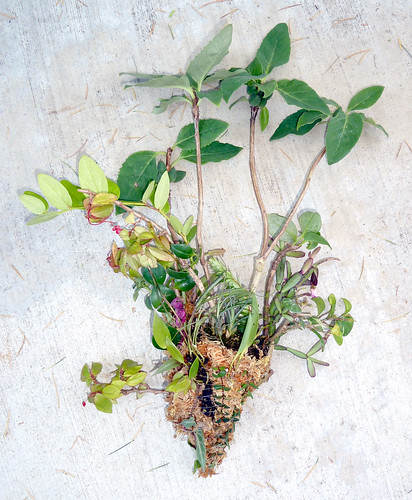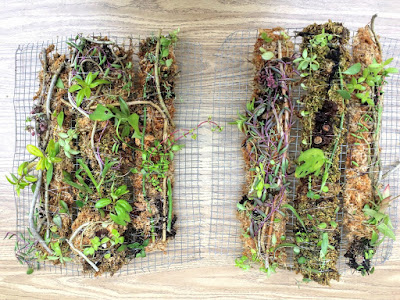For example, a couple weeks ago I attached the simplest bundle to Carol's avocado tree. First I put a layer of wet NZ Sphagnum moss on a paving stone on my lap. I sprinkled some Osmocote on top...
Then I put on another layer of wet moss...
Next I added Cycas debaoensis and Disocactus amazonicus as well as another layer of wet moss...
In most cases I put the entire plant including the roots on top of the moss. In this case though I decided to cover the roots. I firmly and repeatedly pressed down on the moss for a while before using fishing line to tie it all together...
Then I added a small piece of live green moss on top. If the moss establishes then it will actually create more medium.
Lastly I used fishing line to attach the bundle to the tree directly above a Platycerium superbum...
Virtually all plants LOVE growing in Staghorns, hence Rule #17.
I feel like the key part is that the moss must be tightly compacted. If the moss is too loose then it will dry out a lot faster. So this is why when I make a bundle I use wet moss. Naturally it is easier to press down than dry or damp moss. It also helps to use a lot of fishing line. I use enough fishing line so that there is around a half inch between loops.
Here's a bundle that I made a decade ago...
I attached the bundle to my tree and the only plant still alive is the Anthurium scandens (xerophytic form). You can see more pics here... Epiphyte Grand Prix.
One version of the bundling method is to first attach the plants to a flat piece of wood. Then, when the plants are very established, they can be easily removed and attached to a branch. I used this method with some ferns...
The ferns included Lepisorus bicolor, Drynaria sparsisora and a NOID Pyrrosia. It is just over a year later and all three ferns are still alive on Carol's avocado tree.
Here's another version...
It looks like I attached three bundles to both pieces of wire mesh. But I didn't. Instead I put the moss and plants on top of the mesh and attached them using fishing line. It wasn't very easy. The two bundles went on Carol's avocado tree as well, right next to Cattleya orchids.
On my own tree in a few cases the bundles started to dislodge themselves when the fishing line quit working. The branches were too smooth for the plants to really root onto. In situations like this it is a good idea to put the bundle next to a Cattleya. The orchid roots will quickly grow into the bundle and attach it to the branch.
Speaking of orchid roots...
A year or two ago I easily removed this clump of orchids and succulents (Kalanchoe uniflora is so good!!!) from my tree. I think they had grown into a space that I needed to be in when I climb the tree. They essentially formed a bundle. I took the bundle to a cozy plant party where I split it up to share. Carol got a piece that I attached to her tree. She also won a piece that I auctioned, which I attached to a piece of wood...
Largish plants are generally easier to bundle...
This bundle, which went on Carol's tree, included Hoya bella, Kalanchoe blossfeldiana, Hatiora gaertneri and Hoya carnosa Chelsea.
Today I made a couple bundles of mainly small plants...
It was rather painstaking to try and avoid putting the fishing line directly on top of any leaves. Part of the problem was that I probably included too many plants!
In terms of plant selection, naturally you want to bundle plants with more or less the same requirements. Some disparity in requirements is ok because conditions change, which is why the only survivor of my 1st Epiphyte Grand Prix was the Anthurium scandens. It was more drought tolerant than its competition.
In theory it might be a good idea to include the least related plants in a bundle...
Since then, many experiments have shown that multi-species plots are more productive. Cadotte's experiment showed for the first time that species with the greatest evolutionary distance from one another have the greatest productivity gains.[...]What's going on isn't mysterious, Cadotte says. Distantly related plants are more likely to require different resources and to fill different environmental niches -- one might need more nitrogen, the other more phosphorus; one might have shallow roots, the other deep roots. So rather than competing with one another they complement one another. - Productivity Increases With Species Diversity, Just as Darwin Predicted
Plants I typically include in a bundle are...
Aroid - ie Anthurium scandens
Cactus - ie Rhipsalis
Crassulaceae - Kalanchoe uniflora
Fern - ie Microgramma vaccinifolia
Gesneriad - ie Columnea Elmer
Hoya or Dischidia - ie Hoya serpens
Peperomia - ie Peperomia pecuniifolia
One of each is a pretty good bundle.
Typically I don't include orchids, since most of my favorite orchids are safer without moss, but there are some exceptions... such as Dockrillia pugioniformis. If I had enough of it I would probably include it in most bundles.
In terms of Begonias, I don't usually include any in bundles. There has to be a good one for SoCal bundles but I haven't found it yet. Maybe the closest that I can think of is Begonia fisheri. Looking at the above list though, all the example plants are more or less trailers, which B. fisheri is not. Begonia solananthera is a trailer but I somehow killed the cutting that Michelle gave me and I'm too embarrassed to ask for it again.
I'm finally growing Begonia radicans! Hopefully it will become the one Begonia that I typically include in bundles!
The main motivation for this blog entry is that this week I sent some plants to my new friend Keith in Tampa Florida...
Orchids...
Dockrillia lichenastrum x teretifolium
Dockrillia pugioniformis
Encyclia nematocaulon seed pod
Epidendrum Little Miss Sunshine
Epiphronitis Veitchii
Lambara Five Aces
Laelia anceps division from seed germinated on tree
Laelia (lundii & purpurata)
Laeliocattleya Clayton Waglay
NOID seedling germinated on tree
Prosthechea vitellina x Green Hornet
Psychilis macconnelliae X Myrmecophila thompsoniana aurea
Others…
Anthurium lanceolatum
Anthurium scandens (xerophytic)
Columnea Elmer cutting x 2
Columnea schiedeana cutting
Crassula spathulata cuttings x 6
Dischidia sp Irian Jaya
Echeveria rosea
Hoya australis keysii
Hoya serpens
Kalanchoe Orangery (K. manginii × K. jongmansii)
Kalanchoe Tessa (K. gracilipes x K. manginii)
Kalanchoe uniflora x 2
Lemmaphyllum microphyllum (from nursery)
Lemmaphyllum microphyllum (from my tree x 2)
Microgramma vaccinifolia x 2
Peperomia pecuniifolia
Peperomia villosa
Rhipsalis clavata
Rhipsalis NOID Puerto Rico x 2
Selenicereus inermis
Tillandsia aeranthos x 4
Tillandsia albertiana
Tillandsia bandensis
Tillandsia capillaris
Tillandsia capillaris 'Pitchfork'
Tillandsia edithae
Tillandsia funckiana
Tillandsia ionantha
Tillandsia myosura (adult and seedling)
Tillandsia Mystic Albert (albertiana x stricta)
Tillandsia retorta
Tillandsia tricholepis
Tillandsia usneoides
Vriesea flammea
He initially asked me for some recommendations of orchids to attach to his tree. I ended up becoming too curious about how some of my fav epiphytes would do Florida. I told him about my bundling technique but figured that it would be worth it to post some pics. Voila!
Hopefully you've all been inspired to attach bundles of plants to all the branches in the world! Please let me know if you think of a more effective or efficient way to attach a wide variety of plants to trees.















No comments:
Post a Comment